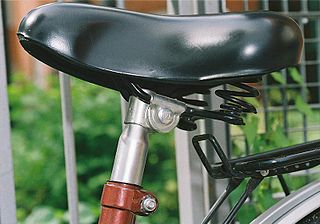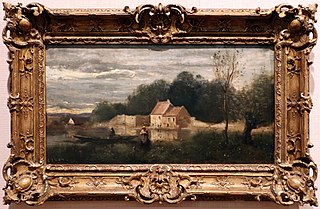
Oil painting is the process of painting with pigments with a medium of drying oil as the binder. It has been the most common technique for artistic painting on wood panel or canvas for several centuries, spreading from Europe to the rest of the world. The advantages of oil for painting images include "greater flexibility, richer and denser colour, the use of layers, and a wider range from light to dark". But the process is slower, especially when one layer of paint needs to be allowed to dry before another is applied.

Canvas is an extremely durable plain-woven fabric used for making sails, tents, marquees, backpacks, shelters, as a support for oil painting and for other items for which sturdiness is required, as well as in such fashion objects as handbags, electronic device cases, and shoes. It is popularly used by artists as a painting surface, typically stretched across a wooden frame.

A mortiseand tenon joint connects two pieces of wood or other material. Woodworkers around the world have used it for thousands of years to join pieces of wood, mainly when the adjoining pieces connect at right angles.

A beehive is an enclosed structure in which some honey bee species of the subgenus Apis live and raise their young. Though the word beehive is commonly used to describe the nest of any bee colony, scientific and professional literature distinguishes nest from hive. Nest is used to discuss colonies that house themselves in natural or artificial cavities or are hanging and exposed. Hive is used to describe an artificial/man-made structure to house a honey bee nest. Several species of Apis live in colonies, but for honey production the western honey bee and the eastern honey bee are the main species kept in hives.

A stretcher, gurney, litter, or pram is an apparatus used for moving patients who require medical care. A basic type must be carried by two or more people. A wheeled stretcher is often equipped with variable height frames, wheels, tracks, or skids. Stretchers are primarily used in acute out-of-hospital care situations by emergency medical services (EMS), military, and search and rescue personnel. In medical forensics the right arm of a corpse is left hanging off the stretcher to let paramedics know it is not a wounded patient. They are also used to hold prisoners during lethal injections in the United States.

The headset is the set of components on a bicycle that provides a rotatable interface between the bicycle fork and the head tube of a bicycle frame. The tube through which the steerer of the fork passes is called the head tube. A typical headset consists of two cups that are pressed into the top and bottom of the headtube. Inside the two cups are bearings which provide a low friction contact between the bearing cup and the steerer.

Scene at the Signing of the Constitution of the United States is a 1940 oil-on-canvas painting by Howard Chandler Christy, depicting the Constitutional Convention signing the U.S. Constitution at Independence Hall in Philadelphia on September 17, 1787. Along with Washington Crossing the Delaware by Emanuel Leutze, the painting is one of the most famous depictions of the early days of the United States. Christy created the painting in April 1940; it is so large that he painted it in a sail loft. It currently is displayed along the east stairway in the House of Representatives wing in the Capitol building.

A collet is a segmented sleeve, band or collar. One of the two radial surfaces of a collet is usually tapered and the other is cylindrical. The term collet commonly refers to a type of chuck that uses collets to hold either a workpiece or a tool but has other mechanical applications.

A bicycle seatpost, seatpin, saddlepole, saddle pillar, or saddle pin is a tube that extends upwards from the bicycle frame to the saddle. The amount that it extends out of the frame can usually be adjusted, and there is usually a mark that indicates the minimum insertion. Seatposts can be made of steel, aluminum, titanium, carbon fiber, or aluminum wrapped in carbon fiber.

A chuck is a specialized type of clamp used to hold an object with radial symmetry, especially a cylinder. In a drill, a mill and a transmission, a chuck holds the rotating tool; in a lathe, it holds the rotating workpiece.

A machine taper is a system for securing cutting tools or toolholders in the spindle of a machine tool or power tool. A male member of conical form fits into the female socket, which has a matching taper of equal angle.
In computer user interfaces, a cursor is an indicator used to show the current position for user interaction on a computer monitor or other display device that will respond to input from a text input or pointing device. The mouse cursor is also called a pointer, owing to its resemblance in usage to a pointing stick.

A picture frame is a protective and decorative edging for a picture, such as a painting or photograph. It makes displaying the work safer and easier and both sets the picture apart from its surroundings and aesthetically integrates it with them.

Rabbit-skin glue is a sizing that also acts as an adhesive. It is essentially refined rabbit collagen, and was originally used as an ingredient in traditional gesso.

A stretcher bar is used to construct a wooden stretcher used by artists to mount their canvases.

Gallery wrap is a method of stretching an artist's canvas so that the canvas wraps around the sides of the stretcher bar or strainer bars and is secured to the back of the wooden frame.

A canvas print is the result of an image printed onto canvas which is often stretched, or gallery-wrapped, onto a frame and displayed. Canvas prints are used as the final output in an art piece, or as a way to reproduce other forms of art.

A strainer bar is used to construct a wooden stretcher frame used by artists to mount their canvases. They are traditionally a wooden framework support on which an artist fastens a piece of canvas. They are also used for small-scale embroidery to provide steady tension, affixing the edges of the fabric with push-pins or a staple gun before beginning to sew, and then removing it from the frame when the work is complete. Strainer bar frames are usually in the shape of a rectangle, although shaped canvases are also possible.

A screw and a bolt are similar types of fastener typically made of metal and characterized by a helical ridge, called a male thread. Screws and bolts are used to fasten materials by the engagement of the screw thread with a similar female thread in a matching part.

The conservation and restoration of paintings is carried out by professional painting conservators. Paintings cover a wide range of various mediums, materials, and their supports. Painting types include fine art to decorative and functional objects spanning from acrylics, frescoes, and oil paint on various surfaces, egg tempera on panels and canvas, lacquer painting, water color and more. Knowing the materials of any given painting and its support allows for the proper restoration and conservation practices. All components of a painting will react to its environment differently, and impact the artwork as a whole. These material components along with collections care will determine the longevity of a painting. The first steps to conservation and restoration is preventive conservation followed by active restoration with the artist's intent in mind.



















